Finding your Creative Voice: 10 tips and insights

How do you find your individual style? It’s probably one of the most asked questions by creatives and illustrators everywhere, and one which isn’t easy to answer.
Last Wednesday night, Illustrators Sue Gent and Caroline Pedler brilliantly tackled the big question together, presenting their insights and reflections in the latest Devon & Cornwall Illustrators AOI online meet-up. Caroline shared many of her experiences developing a new body of work over the last five years (which we share throughout this piece), and below we present a list which summarises the conversations and advice shared in this exciting event.
We will start this article with the same disclaimer shared in the event: there isn’t a clear step-by-step, and nobody has all the answers. Finding your ‘style’, or a preferred way of working, is a very individual journey which nobody else can do for you. It’s about achieving a sweet middle ground between condensing your personality visually, and creating a language that can be enjoyed by others. While the results can take time to bubble, there are cautions and elements illustrators can consider throughout their creative journeys:
* Don’t be a victim of your own success, or your insecurity
While it’s crucial to get commercial work (illustrators need to make a living after all!), it’s important to not sacrifice personal development. It’s also equally important to create self-initiated work in quiet periods to push your practice further. If your portfolio ends up becoming an inaccurate reflection of your ethos or your goals, invest time and energy to steer the wheel in a direction of your preference. You are in control.
* Don’t forget the artist in you
Trends and new technologies come and go. For longevity, you must enjoy what you’re working on in the present and future – if you dislike how you’re approaching illustration work now, take the time to re-invent yourself and reflect. Allow yourself to be intuitive – change and play is part of the process.
* Set yourself personal projects
It can be an individual image, or a series. The key is to not force a clear outcome, but to do it for the sake of experimentation. Caroline Pedler began a daily collage project every day of the year in 2016, and as a result, a new illustrative way or working was developed. Moments of solitude (going on walks, having a coffee by yourself) are often the best ways to spark ideas, without other distractions getting in the way.
* Be open
Branch out of obvious inspirations – look beyond contemporary illustration and take influence from other sources like sculpture, film, and other mediums you don’t necessarily practise yourself. This can help build distance, and reduce comparison with other artists and illustrators. Be open to stepping outside of the box, and try things you wouldn’t necessarily consider at first.
“The most successful illustrators are curious” – Caroline Pedler
* Failure is good!
Failure is a big part of the journey, a big part of being a creative too, and it’s best not to antagonise it. If you don’t like a drawing you did for yourself, that’s ok – finish it and carry on to the next one. Keep the failed experiments as part of your own archive. These tests can inform the next drawing you do, and inform your process overall. Don’t get caught up on self-imposed expectations or ideal scenarios, allow yourself to play and to make mistakes.
* Be honest
This was one of the phrases that kept being mentioned throughout the chat. It’s good to stop sometimes, look at your body of work and reflect: do I see myself here? Is this representative of where I am at the moment? If the answer is no, then move on the next drawing and keep reflecting. The more you reflect, understand yourself, ask questions and realise what you’re happy creating, the easier it will be to see a clear pathway. Once you see a direction you’re happy with, this will inform what kind of commercial work you’d like to focus on next and what strategies you need to put in place to make it happen.

* Can you have more than one style?
This is another big question in the illustration world, one with many opinions. Caroline shares it’s fine to work in different ways, but may be best to limit it to two styles if possible. Try for it to not come out of a place of fear or insecurity, but out of confidence within your abilities. Some artists enjoy being versatile and multifaceted, others prefer to have one recognisable visual language. There are no rights or wrongs, just what’s right for you.
* What to do when you get stuck?
A blank piece of paper or solitude (or both) can be the worst enemies for some illustrators. If self-direction becomes a challenge, try investing in other activities: attend a workshop or a meet-up, sign up to an online course, collaborate with a peer. Others’ feedback and direction can be the right push to spark a new idea, or pick up where you left from. Also, breaks are essential for your physical and mental wellbeing – sometimes space is all you need to re-energise and get back to creating.
* Why is it difficult?
Illustration is storytelling, problem solving and communication, which aren’t easy feats! Nobody has an easy rite of passage, no matter how easy it looks from the outside. Instead of getting frustrated by the difficulties, reflect on what you’ve learned and achieved. Even if these don’t seem like big successes at the time, these small learnings will pave the way for positive and flourishing outcomes in the future.
* Be persistent: it takes time
As highlighted many times in the talk, and throughout this summary, there isn’t a linear way of achieving that unique voice. It’s a process that’s very much down to each illustrator and artist – but with the right headspace, resources, support, perseverance, and willingness to experiment, you can evolve your practice and set yourself for a long and fruitful career.
Resources shared during the event:
- Podcasts: Creative Pep Talk by Andy J. Pizza
- Books: The Tao Of Bowie: 10 Lessons from David Bowie’s Life to Help You Live Yours by Mark Edwards
- Essays: ‘Educate, Agitate, Abdicate’ by Paul Bowman, ‘An Introduction to the manifesto for illustration pedagogy: A lexicon for contemporary illustration practice’ by Mireille Fauchon & Rachel Gannon
- Directories: AOI Directories, Writers’ and Artists’ Yearbook
Many thanks again to Sue Gent for hosting the event, Caroline Pedler for her insight (and brilliant illustrations, used throughout this summary), and to all who attended last Thursday!
The next Devon & Cornwall Illustrators Meet-up in this 22nd April. It’s free and you can RSVP here.
Check out more AOI events, meet-ups and other industry events here. If you are interested in hearing about future physical and online meet-ups in Birmingham, Sheffield, Edinburgh, Cambridge, or other local areas, please let us know here.
Back to News Page




